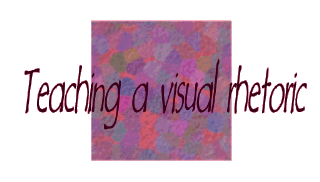In my first semester as a freshman
composition instructor, feeling a bit overwhelmed, I taught the
traditional essay form and collected formal papers from my students
on a weekly basis. As the semester wore on and I became more familiar
with electronic media, thanks in large part to the resources available
at NIU, I decided to offer an extra credit Web assignment for my
students. I spent only two class periods talking about electronic spaces,
their form and functionality. We surfed and commented on images, links,
and text. I was pleased with the response and my students seemed delighted
to step away from the traditional essay form. Yet, when they were given the
opportunity to design their own Web spaces my students did what I felt was
the unthinkable. They did not design their pages by the few electronic samples
I had shown them, but instead they designed their Webs to follow the strict
parameters of the academy. I was pleased with their unbridled enthusiasm,
but their overall bad design practices disturbed me. I had gaudy cartoon
images, flashy animations, dark texts against busy dark background
images, or no design at all. The idea that the assignment wasn’t actually
“graded,” and the notion that they could do whatever they desired, save
something completely inappropriate under NIU guidelines, made everyone
willing to at least try. But what were they trying to do? Were they applying
current marketplace practices or mimicking the rules of the academy? There
was no generalization, no carry-over of skills from one genre to another.
If we say that what we are really teaching our students is critical analysis
and written communication skills, then we fail if we don't teach them to
generalize their writing for their specified audience. Electronic writing
operates under a different set of rules, offers a new kind of literacy. We
must teach our students to both understand and transcend the traditional
form, to mold it for the electronic space, thus creating a variant which
considers the electronic audience addressed, and his or her expectations
as reader/ learner.
RESEARCHING SUBJECT...
Today we are seeing an undeniable shift from written
rhetoric to visual rhetoric, and we can expect the process to move
slowly, but perhaps we should take notice. According to Walter Ong:
“histories of the relationship between literature and culture have
something to say about the status and behavior of readers” (56). After
viewing my initial attempts at incorporating technology after the fact,
and doing so without regard for the basic principles of visual rhetoric,
it is easy to see why my students failed to meet the mark, and why I left
the experience feeling overwhelmed and my students left misguided. Simply
put, there was no synthesis between current marketplace practices and
what I was teaching in the computer lab. Did my students learn the difference
between academic writing and electronic marketplace rhetoric? I don't
believe so. Were they able to incorporate elements of both in a cohesive
manner? Certainly not.
The Internet calls to question traditional views
of audience-addressed writing. “By privileging composing as the
main site of instruction,” says John Trimbur, “the teaching of writing
has taken up what Karl Marx calls a ‘one-sided’ view of production
and thereby has largely erased the cycle that links the production,
distribution, exchange, and consumption of writing” (190). Trimbur
also claims that “in writing instruction delivery has been an afterthought
at best, assigned mainly to technical and professional communication
and associated largely with such matters of document design as page
layout, typography, visual display of information, and Web design”
(190). As rhetors, we must redirect our focus to reflect the changing
literacies of our readers. Delivery is no longer only for the technical
and professional writer; the principles of visual display and Web design
need to become transparent aspects of every composition class, regardless
of whether or not the instructor has the ability to physically design sites
for the Internet.
|
